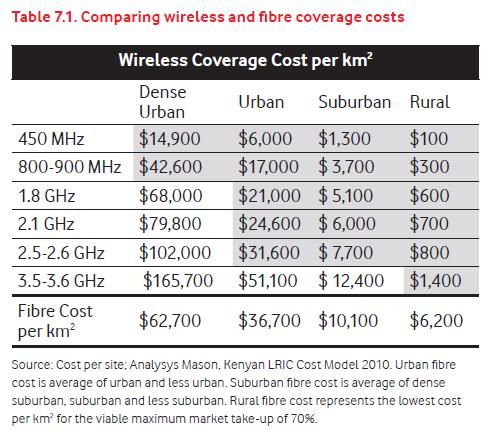Highlights from Vodafone’s mobile broadband report
Vodafone’s recent policy report, “Making broadband accessible to all,” gathered expert opinion on what is shaping broadband policy in developing nations and how governments/operators/end-users should actually shape the policy. Everyone interested in African ICT should at least glance over the first couple of chapters. The bottom line is that developing nations need different policies than developed nations. Plus, policy makers must carefully consider what is occurring on the ground (demand == end-user) and in the market (supply == operator). A few points from the Vodafone that immediately stand out are included below:

Wireless deployments are often cheaper than fibre deployments, even in dense urban areas. {Vodafone, 56}
Components that enable broadband delivery (pg. 4):
- international connectivity: ex. SEACOM
- national connectivity: ex: backbones
- local access: ex: connectiving end-users
- end user devices: ex: PC/tablet vs. mobile
Fixed vs. mobile stats (pg. 5):
- issue with ITU measuring connectivity by fixed broadband subscriptions (households vs. persons) and then mobile which relies on 3G
- apparent in Egypt, South Africa, Kenya, Nigeria, Tanzania
- bad statistics lead to misinformed policy
- better snapshot involves industry analysts, openerating comopanies, capable networks, end user handset capability, and end-user data subscriptions
Growth projections (pg. 6):
- 2009-2015: fixed broadband subscribers to grow from 1.8 to 3.9 million. mobile broadband subscribers to grow from 120 to 435 million
Compelling few paragraphs on how high-level research can mislead policy (pg. 7):
- unfounded evidence that GDP increases by ~1% with every 10% increase in broadband penetration
Focus group results in Kenya (pg. 15-16):
- social shift in mobile Internet usage from better-off to poor
- mobile Internet often used at home
- mobile pricing (data-based) may be more lucrative than cyber pricing (time-based)
Erik Hersman’s chapter (reviewed on his site as well) (pg. 21-30):
- international content actually creates a pathway for local content (high demand causes network costs to drop)
- lack of m-government policies
- lack of cost-sharing between governments and operators
Spectrum (pg. 39):
- need to open spectrum to productive users while maintaining rivalry in the marketplace
Deployment costs (pg. 57-59):
- the deployment of wireless coverage is cheaping than fibre in all geotypes for the spectrum below 900 MHz
- GPRS: 0.08 Mbps can only handle e-mail
- EDGE: 0.23 Mbps can handle basic Internet, e-gov, e-health
- 3G HSDPA: 2Mbps for video












 Twitter
Twitter Facebook
Facebook Pinterest
Pinterest
[…] https://www.oafrica.com/mobile/vodafones-mobile-broadband-report/ […]